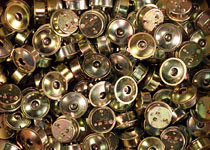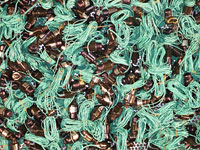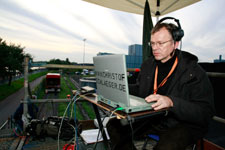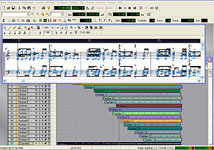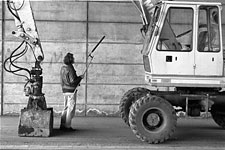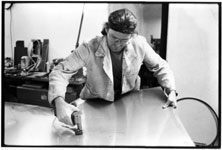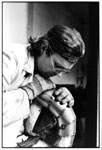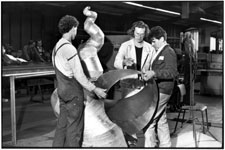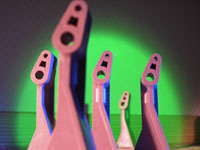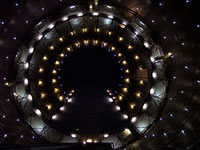|
|
|
Catalog
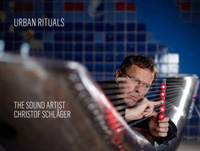 |
Urban Rituals,
The Sound Artist Christof Schläger
Verlag Hanno Ehrler
PDF
|
catalog 'Urban Rituals,
The Sound Artist Christof Schläger'
I.
Construction of Instruments
The construction of individual, self-made instruments
has its origin in the experimental music movement of the twentieth century. Perhaps the most famous builder
of such instruments was the U.S. American, Harry Partch (1901-1974), who constructed whimsical, often quite
large acoustic sound generators the tuning of which was based on microtonal scales that divide the octave
into 43 unequal tones that are derived from the natural harmonic series. Partch used scales that allowed for
more tones of smaller intervals than the standard Western tuning which uses twelve equal intervals to an
octave. He used a quite different, microtonal harmony. This opening and exploration of new sound worlds
inspired many musicians and artists to build their own instruments. Christof Schläger is one of them.
Schläger feels that classical instruments despite their present level of perfection resulting
from several centuries of development have a limited sound capacity/range. "The piano is no
longer sufficient for me," he says. As his like-minded colleagues he feels constricted by the
standardization of the instrument and the tuning system it represents. With his self-constructed
machines the artist wants to leave the foundation on which Western music is based and move
toward an unknown terrain into an unstructured, unchartered sound space - anarchical in its
original intention, without a beginning, without a history.
Experiences with sound inspired Christof Schläger to pursue this path. "In the end, I found the
piano simply too limiting," he claims. "When I look at it now, Pythagoras is in the forefront of
my mind, the harmony of sounds, their relationships, and so on. This contradicted causally a
completely different experience, which I had found in my surroundings. This world was filled with
machines, sounds, a universe of clamor, of noise, often threatening of course, but at the same time
fascinating.
|
|
Christof Schläger originally studied process and constructional engineering and enjoyed some
years of piano lessons. After deciding to discontinue his engineering studies to devote his
time to his art, he began to make sound recordings in industrial facilities, coalmines, on
canals, and on/under autobahn bridges. When he replayed these recordings he found himself
dissatisfied by what he realized was the inevitable difference between the actual sounds
he was hearing and the quality of the audio reproduction which lacked the immediacy of the
experience of live sound and the essential mystery inherent in it. From that time he knew
what he wanted to achieve, he wanted to create something that could be experienced immediately,
directly, and spontaneously.
Schläger began altering the piano by inserting thumbtacks into the area of felt on
the hammers that comes into contact with the strings; he further attached metal chains
to the strings. Later he abandoned the "prepared piano" (John Cage) completely and
created larger than man-sized air sculptures from inflatable hosepipe systems. In the
process, he explored the acoustical aspects of these architectural sculptural objects.
In 1984, the first sound machines materialized. Their acoustical emanations initially
had no clear pitch. The instruments produced a whole universe of differing sounds, to
which the typical environmental noises of the Ruhr region can be constantly traced.
Later machines began to evolve which at least partially generated clear sound pitches,
yet colored by the materials and the construction of the instruments.
|
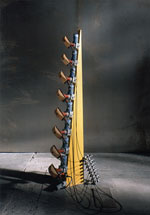

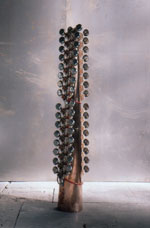
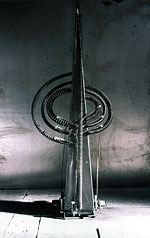

Soundmachines: Quäker, Standzeit, Schellenbaum, Federine und Klapperrappel
|
|
For his sound machines Schläger uses component parts from other machines such as small motors or magnets
of the type found in electric typewriters. He is always looking for such parts just as a violin builder
looks for suitable wood. He places parts of various functions and derivation into new contexts and develops
completely new machines. The record player motors used for Flatterbaum no longer serve as rotation mechanisms
for the playing of phonograph records, but rather for the streaming of paper discs. Schläger chose these
specific motors, because they are small and designed to produce a rotation velocity that lets the plastic
or paper discs of Flatterbaum produce sound without destroying them. If the component parts do not fit and
are therefore unable to function properly, he alters them in whatever way is necessary until they fit precisely.
In order to play these machines, Schläger initially used an industrial control system by Klöckner Möller,
which is still in use for the regulation of waterworks, railways, and traffic lights. However, this method of
programming proved to be cumbersome, he therefore decided to apply the data transfer protocol MIDI (musical
instrument digital interface) which offered him much more convenient options. However, it is necessary to
interpose a laptop with sequencers, compositional and notation programs between the two. With MIDI the
programming of the operations of motors and magnetic pickups is enabled. Although the sound machines are then
ready for use in performances and in installations, they are not considered completed, rather they are subject
to an ongoing process of modification, a constant fine-tuning and adjustment of their sound characteristics.
The construction of a machine is not a completed process, but a never-ending exploration of the best-possible
form. On a pragmatic level Christof Schläger knows in advance the kinds of components he requires and he will
search until he finds the precise part he is looking for; usually it will require some physical alteration to
fit into the structure of his sound machine. On an artistic level, while Schläger has a sound in his imagination
and which he strives for, he is not rigid in his intention. The sounds evolve and come into being in the interplay
of imagination, the constant adjustment of the sound machines, and the listening experiences of the sounds
produced.
|
|
The sound machines are the result of artistic creation, at the same time they are also technically produced objects.
Compared to many everyday machines Schläger's machines are designed to be efficiently functional to the smallest
detail. Some of their parts, particularly the electronics, can be hard to find and expensive to obtain. Nevertheless,
they also have a significant esthetic quality. As art objects they show a close harmony between construction and
function and as such, they can be understood as an allegory for a sensible/intelligent use of technology. "If you
treat machines well, they treat you well," says Ralf Hütter, founding member of the electronic-music band Kraftwerk.
|
|
II. Noise
In the Ruhr region industrial noise was once an acoustic given.
Today, after the decline of the Ruhr industry, the acoustic ambiance of the region has a different form and is less
characteristic. The high population density and the close-meshed highway network generate traffic noise that can be
constantly perceived as a faint background murmur, even at night. In addition to industrial noise, it is especially
what the sonic world is owed by the process of civilization that fascinates and inspires Christof Schläger. The
sound artist speaks about nocturnal noise as something mysterious that goes far deeper than the phenomenon's
apparent simplicity. He is interested in the structures that can be discovered in noise, its variations and different
colors and hues. The presence of noise establishes an esthetical attitude, which is fundamental to Schläger's work.
Noise symbolizes something unordered, obscure, disorganized, multi-layered, pre-formed, unsystematic, free, open,
and undetermined.
|
|
Noise can be described and interpreted quite differently, musically, technically, sociologically, medically,
and philosophically. "As noise we understand all those elements, which interfere with the signal of a message.
This includes every kind of technically based interference, not only for example the noise caused by static
electricity occurring as a result of poor radio or television reception, but also uncertainties of a
discursive and linguistic nature. Black image distortion during a television transmission, stains on a daily
newspaper, but also rumor in a sociological thesis, all of these can be understood as noise.
Physical acoustics describes noise on the basis of how the frequencies of the signal power contained in it are
distributed. The most well-known noise is so-called white noise which describes a sound that contains all audible
frequencies whose signals have equal intensity. White noise, however, does not exist in a pure form. In nature
as well as in electrical equipment, the noise that is primarily generated is known as pink noise, in which many
but not all frequencies occur, but - so the definition of physics - are distributed uniformly by octave range
throughout the audio spectrum.
The Canadian sound artist R. Murray Schafer emphasizes the musical component of noise. "In a large quantity of
rhythms one rhythm will be extinguished by another. The main characteristic of the urban soundscape is random
movement, and it can be heard most clearly from a distance or in the deep of the night. It is the continuous low
frequency sound that can be heard from a neighboring hill or through an open window in the early morning hours.
|
|
In 1827, the Scottish botanist Robert Brown observed that grains of pollen suspended in water execute irregular
movements. They are kicked off by the water molecules which depending on their temperature move either slower
or faster. This so-called Brownian molecular motion can only be described statistically. It is not predictable
in detail and because of its uncertainty can be described as noise. Structural uncertainty, regardless of
whether it concerns an acoustic, optical, physical, or theoretical issue, defines noise.
Noise is therefore also an art-esthetic and a philosophical category. In relationship to art the philosopher
Martin Seel interprets noise as a borderline example of perception, an optical or acoustic event, between which
it is completely impossible or very difficult to differentiate. "It is, however, rare that nothing could be
differentiated in noise; often it occurs as a diffusion of the distinguishable, as a permanent shrinkage or
transformation of gestalt, which makes a safe execution of the transformation that occurs impossible. […]
Furthermore in regard to noise, specific values can be distinguished at any time - noise is loud or quiet,
roaring or cracking, creaking or wheezing, whining or swirling, flickering or flowing, spinning or streaming,
swishing or roaring, etc. - but they all are characteristic of the event, which can be perceived or stated,
without actually being able to say something specific about what is actually occurring.
|
|
III. Sound
"European music is based on an artificial construct
of tones and scales, it embodies the antithesis of counter pole to the raw, objective sounding of the world."
Around the middle of the twentieth century, however, even the raw sound of the world became music-capable
material. A significant portion was accounted to the emergence of electronic music, the concept of the
musique concrète, the development of noise-generating play techniques on classical instruments, and
compositional theories and concepts, including for example John Cage's postulation that all sound regardless
of its provenance is music.
|
|
The decisive difference between both the tones that escape from highly cultivated instruments and
the disharmonious, often unwanted and disturbing everyday noises is their ability to be systematized.
The musical tradition formulates tonal systems, in which each tone or each tonal pitch has been
designated a precisely defined place with a specific meaning, regardless of the instrument and
eventually independent of the concrete sound. In this sense, musical meaning is defined by abstract
melodic (horizontal) and harmonious (vertical) relationships of tonal pitches. The parameter of tonal
color plays only a subordinate role in occidental music. On the other hand, it dominates the essence
of noise, for it is predominantly defined by its sound characteristic. While tonal systems like the
twelve-tone tempered scale can be systematically described through their interval relationships, this
is impossible with the sound values of noises. In the Traité des objets musicaux published in 1966,
the French composer and founder of the musique concrète, Pierre Schaeffer, had tried to classify
noises according to their characteristics. But each noise as similar as it may be to others remains
a unique phenomenon, an always singular, unique sound occurrence. That is contradictory to the
formulation of a musical system and is based on the infinitude and freedom that Christof Schläger
claims for his work.
|
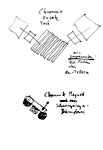

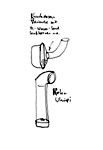

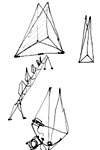

Entwürfe v.l.n.r.: Chromix,
Typedrum, Knackdosen, Hopper, Klapperrappel und Sirenen |
|
Contrary to other instrument builders, Schläger is not interested in developing a musical system.
The construction of his sound machines and their sound worlds therefore does not follow any system.
He follows his intuition. He concentrates on materials and their sound characteristics, he lets the
results be a surprise letting them unfold in the concrete artisanal work to a detailed, precisely
formulated gestalt.
The artist is inspired by the sounds and noises that he encounters in his living environment. He can
recount an experience about each of his individual sound machines whose varied construction is informed
by this inspiration and the sound world that is evoked includes metallic sounds, buzzing, whizzing and
whistling noises, clicking sounds, rattling and ringing in addition to tonal signals. In the sculpture
Schwirrer for example, the noise part is subsumed into the tonal pitch. This sound- and noise characteristic
is a result of the technical construction of the sound machines, but does not include any intention on the
part of the artist to use these devices to imitate technical noises. Their technical impression establishes
rather a symbolic, even allegoric dimension of the sound world, in that it refers to the world in which we
live. Above all, it opens up an experiential space that underlines the intrinsic value of these sounds and
their beauty. The technical instruments and sounds mutate in Christof Schläger's compositions into creations
of fantasy, which allows the emergence of something completely new.
|
|
IV. Komposition
Christof Schläger has found inspiration in both the noises of the modern world and the work of contemporary artists
and composers. He is particularly fascinated by the work of Conlon Nancarrow, who uses mechanical pianos in order
to bring extremely fast, highly complex rhythmical structures to sound. But he is also excited about Mauricio
Kagel's concept of instrumental theater, which puts the action of making music as a scenic element into the
foreground. In 1982, Schläger bought a record with pieces by Luc Ferrari who used recordings of different noise
worlds in his compositions, and in 2003, he performed with Ferrari in a concert in Herne. The composer Trimpin's
installations with self-designed sound generators and sculptor Jean Tinguely's colorful, self-destructing kinetic
machines have also influenced his work. Christof Schläger conceives these art phenomena as a spiritual cloud that
has moved him forward and influenced his compositions.
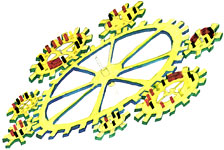
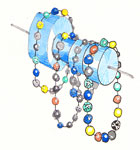
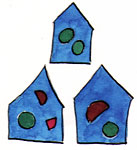
Composition Draws: 'Planetengetriebe',
'Perlenkette' und 'Häuser'
Schläger's compositions are distinguished superficially by a concise percussive aspect that supports the
technical quality of the sound and makes reference to machine rhythms, while going far beyond them. Its
origin lies within a musical gesture in minimal music to which the artist feels a great affinity. Here
repetitive structures dominate the music, they are isolated and edited linearly. Slight variations in
their interior structure occasionally cause small changes, which lead to new combinations and processes.
Much is reminiscent of design principles of music styles such as Hip-hop or Techno, where individual
sound elements are strung together and layered and result in more or less complex, rhythmically interlaced
aural architecture. Schläger uses graphic models for the generation of such complex sequences and layerings.
For example he draws a series of rollers of different sizes, which are painted with patterns and which
revolve against each other. In the process the patterns repeat, but always in new combinations. Other
drawings show cogs adorned with symbols of various sizes. They intertwine in various arrangements and
generate complex structures of symbols, which constantly change.
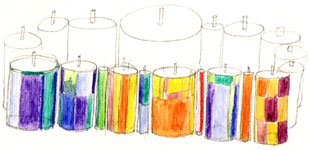
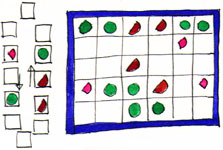
Composition Draws: 'Gebetsmühlen',
und 'Paternosterhaus'
In 2007, it became even more complex when Schläger began to work with ship's horns in exterior spaces sounding
them in areas of square kilometers within the landscape by placing several groups of the horns at a distance
from each other, and aligning the fixed sites with mobile positions on trains or ships. Because of the low
sound velocity of 343.46 meters per second at a temperature of 20º Celsius [68ºF] in dry air, time plays an
important role. Depending on the location of the listener, while the sound from one group of horns may be heard
immediately, up to two seconds may pass before the sound emitted from a more distant group is heard. The tonal
sequences of the ship's horn groups from various points in the performance area blend in different ways and the
tonal combinations experienced depends on the position of a listener in relation to the horn group. The reception
of the horn tone is also affected by objects in its path, such as high buildings for example, and its encounter
with such obstacles and the elements existing in the space itself will contribute to the evolving piece and
inevitably change the timbre of the sound that the listener ultimately hears.
This music has a three-dimensional nature, through the fact that the sounds reach the listener from several directions.
The delicately woven timbres that develop in the exterior spaces spread as an acoustic ambiance over the landscape
and form an interactive relationship with other sounds and noises that are integral to the landscape.
|
|
V. Sculpture
Through the three-dimensional architecture of his sound installations, Christof Schläger's music also
has a sculptural component. As one can walk around a sculpture and view it from different viewpoints
so the listening experience of his music, too, changes as one moves around. Esthetic impression is
also an important facet of Schläger's sound machines and even though their sound may be the principal
purpose the sculptural quality of the devices have their own value. And although the artist is mainly
oriented on the usefulness of the instruments in relation to sound, he has always an eye on their
optical effect as well.
|
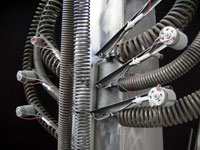


Sound Machines: Federine, Flatterbaum und Standzeit
|
|
Perhaps this is shown most strikingly in one his earliest machines, Federine. The supporting structure of
Federine is in the form of a steep pyramid and as such it embodies a classical motif of architectonic
iconography. Almost tenderly, Schläger mounted metal springs, wires, and rods to the pyramid. In the process
a sculpture reminiscent of a human form emerged the visual aspect of which is in no way secondary to its
function as a sound generator. Both the tonal and the technological aspect are based in technology yet
represent the foundation on which other levels are enabled to come into being; in fact Federine reveals
quite non-technical characteristics of Schläger's work: an infatuation with detail, a sense of playfulness,
and a trace of humor. A similar example is Brauser. Motors fitted with synthetic foils have been mounted on
tall poles, when activated, the foils gyrate generating soft whistling and swishing sounds. Several of
these poles each standing a little more than head-height and close together form the appearance of a tree-like
sculptural form, which like the elements of Federine, reveal the artist's tendency toward filigreed and
fragile structures.
|
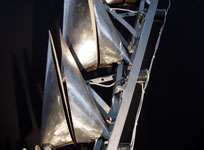
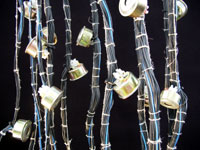
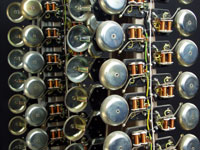
Sound Machines: Klapperrappel, Knackdosen und Telewald
|
|
Christof Schläger references different esthetic signatures to painting, forms, and statures,
which have their origin in modern art movements. The technical affinity of his sound machines
references Futurism with its glorification of technology and Cubism with its angular, interlocking
forms. Schläger's constructions are also slightly reminiscent of sculptures by Alexander Calder
and Yves Tinguely. Like Calder, Schläger designs his sculptures with clear geometric forms which
often appear to be curvaceously broken and through their movements and trembling in play evade
technological geometry. Tinguely inspired the color components of his sound machines. And although
color forms only a subtle element, it essentially characterizes the optical experience.
|



Sound Machines: Schellenbaum, Sirenen und Knister
|
|
Suggestions of Surrealism can be found in the synergy of the forms, especially, when one examines the details
of the sound machines: the interconnections and tangles of small motors, specifically formed dowels
and anchors, multi-colored wires and cables, compressor hoses, rods and mounts, which often resemble
the extremities of insects. Finally, one discovers references to the genre of science fiction with
fantasy figures that get out of hand and relieve Schläger's objects of their further technological
bond contributing essentially to their enigmatic impact.
|
|


